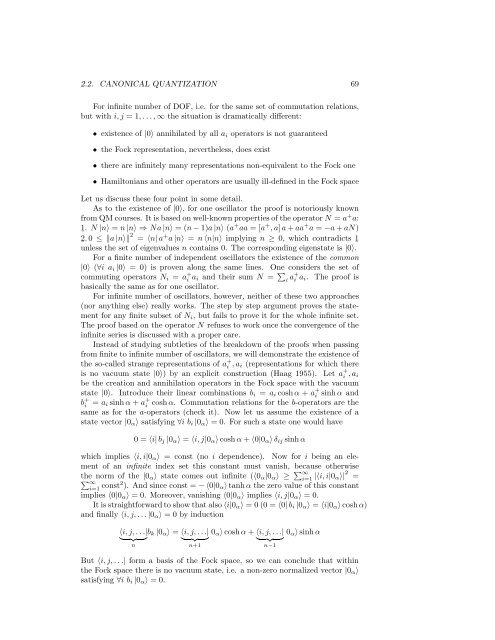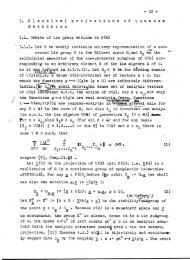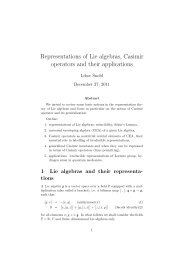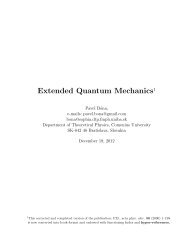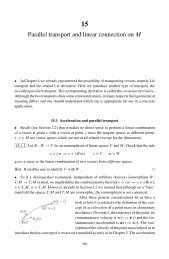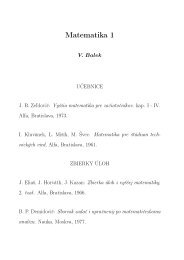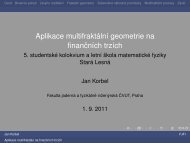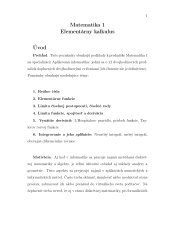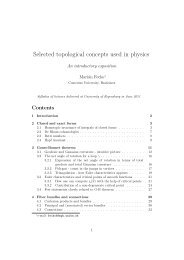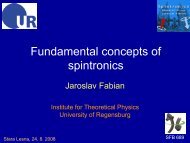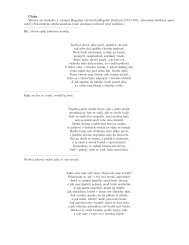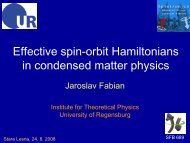Quantum Field Theory I
Quantum Field Theory I
Quantum Field Theory I
You also want an ePaper? Increase the reach of your titles
YUMPU automatically turns print PDFs into web optimized ePapers that Google loves.
2.2. CANONICAL QUANTIZATION 69<br />
For infinite number of DOF, i.e. for the same set of commutation relations,<br />
but with i,j = 1,...,∞ the situation is dramatically different:<br />
• existence of |0〉 annihilated by all a i operators is not guaranteed<br />
• the Fock representation, nevertheless, does exist<br />
• there are infinitely many representations non-equivalent to the Fock one<br />
• Hamiltonians and other operators are usually ill-defined in the Fock space<br />
Let us discuss these four point in some detail.<br />
As to the existence of |0〉, for one oscillator the proof is notoriously known<br />
fromQMcourses. Itisbasedonwell-knownpropertiesoftheoperatorN = a + a:<br />
1<br />
¯. N |n〉 = n|n〉 ⇒ Na|n〉 = (n−1)a|n〉 (a+ aa = [a + ,a]a+aa + a = −a+aN)<br />
2<br />
¯.0 ≤ ‖a|n〉‖2 = 〈n|a + a|n〉 = n〈n|n〉 implying n ≥ 0, which contradicts 1¯<br />
unless the set of eigenvalues n contains 0. The corresponding eigenstate is |0〉.<br />
For a finite number of independent oscillators the existence of the common<br />
|0〉 (∀i a i |0〉 = 0) is proven along the same lines. One considers the set of<br />
commuting operators N i = a + i a i and their sum N = ∑ i a+ i a i. The proof is<br />
basically the same as for one oscillator.<br />
For infinite number of oscillators, however, neither of these two approaches<br />
(nor anything else) really works. The step by step argument proves the statement<br />
for any finite subset of N i , but fails to prove it for the whole infinite set.<br />
The proof based on the operator N refuses to work once the convergence of the<br />
infinite series is discussed with a proper care.<br />
Instead of studying subtleties of the breakdown of the proofs when passing<br />
from finite to infinite number of oscillators, we will demonstrate the existence of<br />
the so-called strange representations of a + i ,a i (representations for which there<br />
is no vacuum state |0〉) by an explicit construction (Haag 1955). Let a + i ,a i<br />
be the creation and annihilation operators in the Fock space with the vacuum<br />
state |0〉. Introduce their linear combinations b i = a i coshα + a + i sinhα and<br />
b + i<br />
= a i sinhα +a + i<br />
coshα. Commutation relations for the b-operators are the<br />
same as for the a-operators (check it). Now let us assume the existence of a<br />
state vector |0 α 〉 satisfying ∀i b i |0 α 〉 = 0. For such a state one would have<br />
0 = 〈i|b j |0 α 〉 = 〈i,j|0 α 〉coshα+〈0|0 α 〉δ ij sinhα<br />
which implies 〈i,i|0 α 〉 = const (no i dependence). Now for i being an element<br />
of an infinite index set this constant must vanish, because otherwise<br />
the norm of the |0 α 〉 state comes out infinite (〈0 α |0 α 〉 ≥ ∑ ∞<br />
∑ i=1 |〈i,i|0 α〉| 2 =<br />
∞<br />
i=1 const2 ). And since const = −〈0|0 α 〉tanhα the zero value of this constant<br />
implies 〈0|0 α 〉 = 0. Moreover, vanishing 〈0|0 α 〉 implies 〈i,j|0 α 〉 = 0.<br />
Itisstraightforwardtoshowthatalso〈i|0 α 〉 = 0(0 = 〈0|b i |0 α 〉 = 〈i|0 α 〉coshα)<br />
and finally 〈i,j,...|0 α 〉 = 0 by induction<br />
〈i,j,...| b k |0 α 〉 = 〈i,j,...|<br />
} {{ } } {{ }<br />
n n+1<br />
0 α 〉coshα+〈i,j,...| 0 α 〉sinhα<br />
} {{ }<br />
n−1<br />
But 〈i,j,...| form a basis of the Fock space, so we can conclude that within<br />
the Fock space there is no vacuum state, i.e. a non-zero normalized vector |0 α 〉<br />
satisfying ∀i b i |0 α 〉 = 0.


